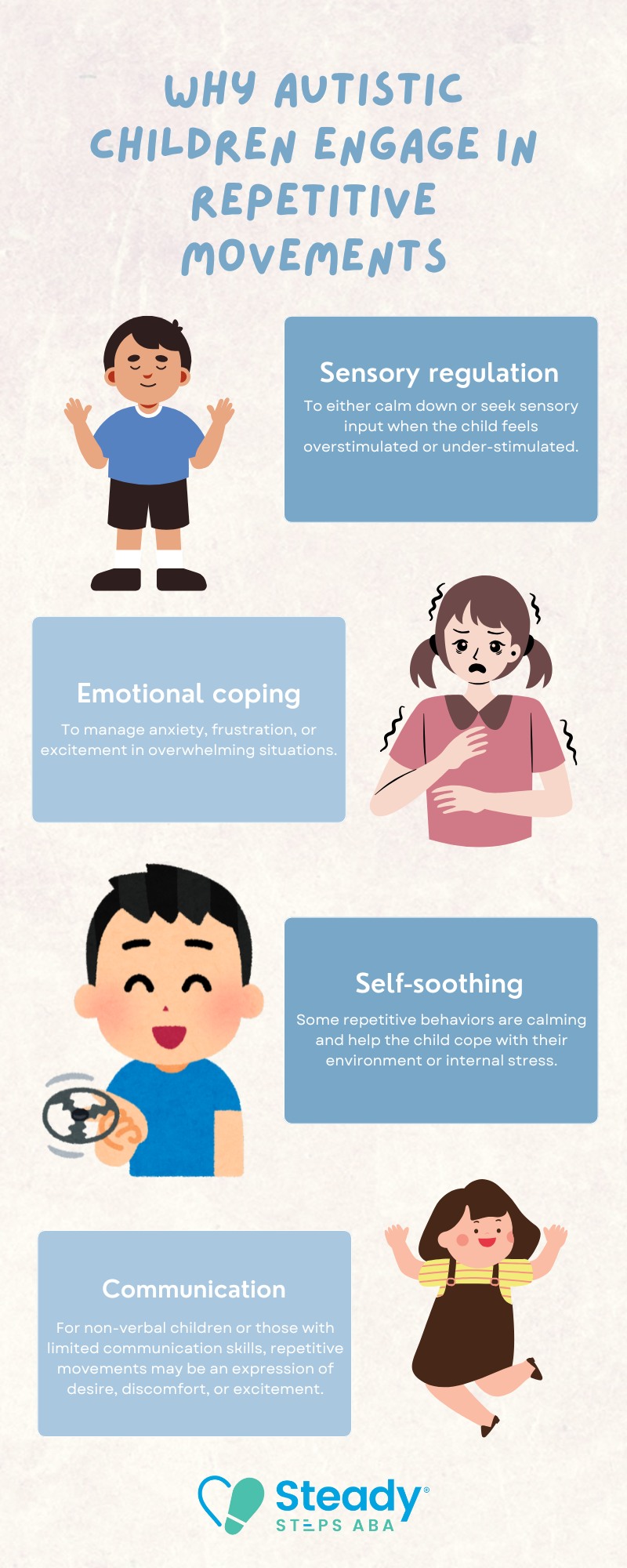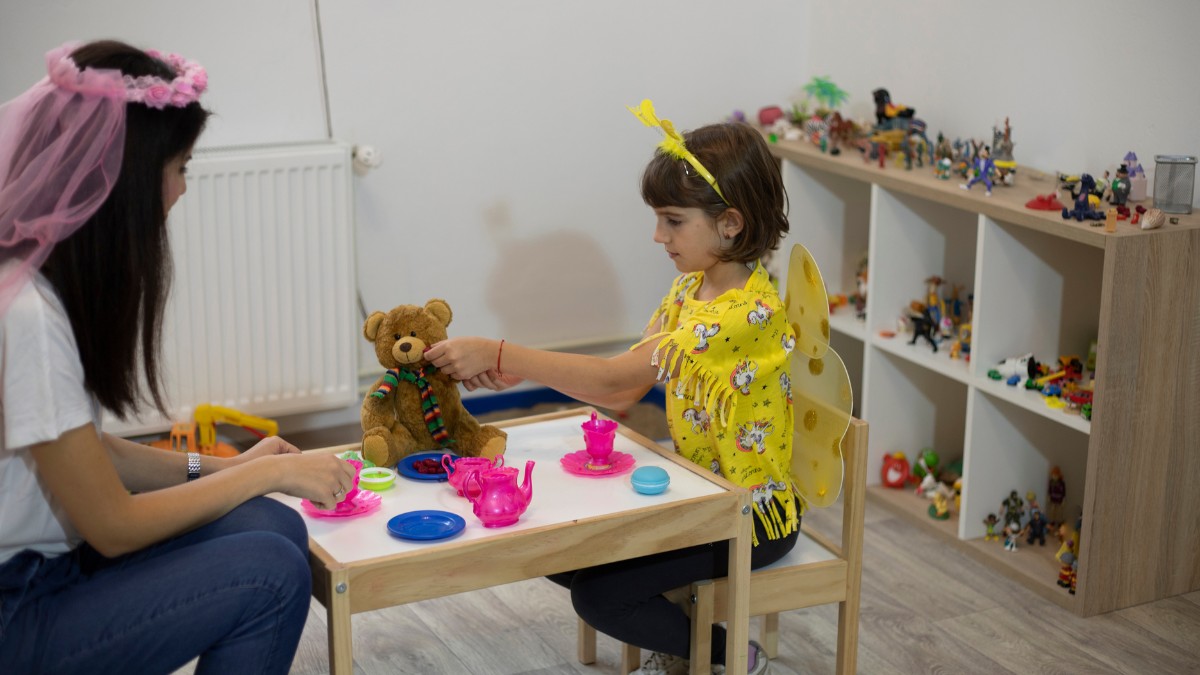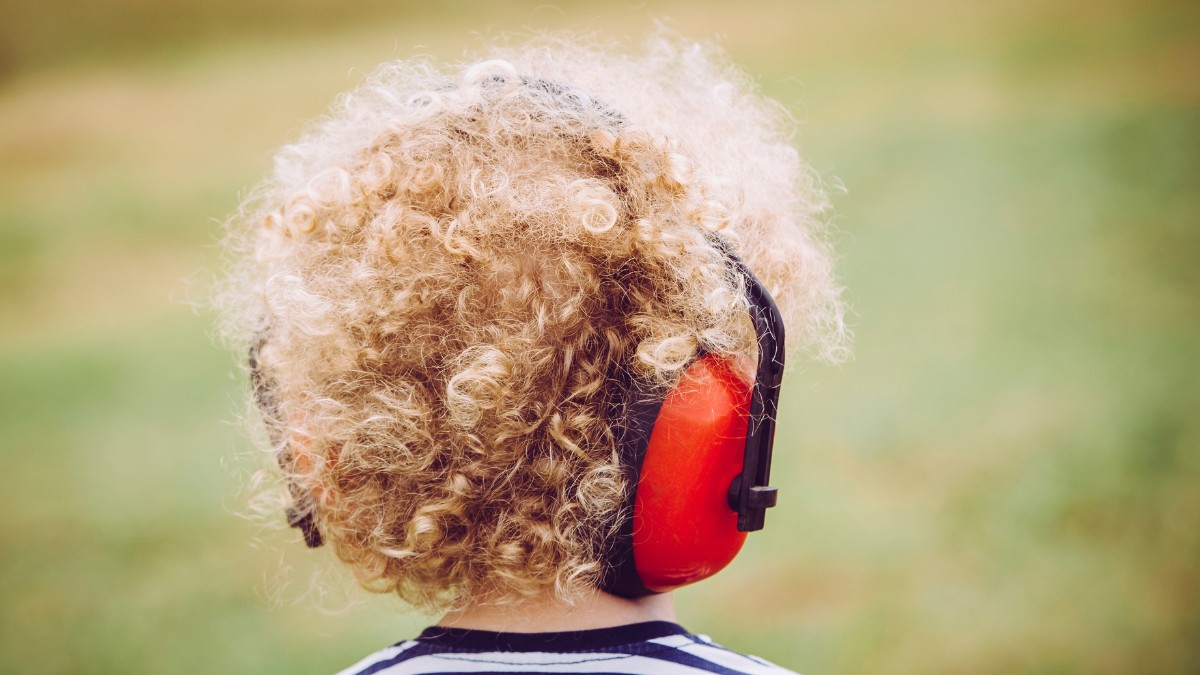Key Points:
- Repetitive movements are common in children with autism, and these behaviors often serve various purposes, such as self-regulation, stimulation, or expression of anxiety.
- Understanding the causes of repetitive movements in autism can help parents, caregivers, and professionals address these behaviors effectively.
- ABA therapy is an effective way to manage repetitive movements and teach children with autism new ways to communicate and self-regulate.
Repetitive movements in autism are a hallmark of the condition and can be observed in many children on the spectrum. These movements, often referred to as stimming (self-stimulatory behavior), are repetitive actions or sounds and are prevalent in approximately 44% of autistic individuals. For children with autism, these behaviors are a way to cope with their environment, regulate sensory input, or manage emotions.
Repetitive movements can vary widely and are highly individualized. They can include things like hand-flapping, rocking, spinning, or repeating words or phrases. These behaviors may seem odd to others but serve important functions for the child. Understanding the purpose behind these movements can help parents and caregivers provide the right kind of support and intervention.
In this article, we’ll explore examples of repetitive movements in autism, the reasons behind these behaviors, and ways to address them.
5 Common Examples of Repetitive Movements in Autism
Repetitive movements can take many forms, depending on the individual child. Some of the most common examples include both physical movements and vocalizations. These behaviors may happen spontaneously, particularly in stressful or overstimulating environments, or they may be part of a regular routine.
Some children may engage in these movements to seek out sensory stimulation, especially if they are feeling under-stimulated or overwhelmed. Others may use them as a way to self-soothe or cope with stress and anxiety.
Common examples of repetitive movements in autism include:
1. Hand-Flapping
Involves rapidly moving the hands up and down, often in response to excitement or stress. This movement can provide sensory feedback and help children cope with overwhelming emotions or situations.
2. Rocking or Body Swaying
Involves moving the body back and forth while sitting or standing, often a way to self-regulate during times of stress or overstimulation. This repetitive motion can offer comfort and a sense of control in an unpredictable environment.
3. Spinning Objects
Involves twirling or spinning toys, objects, or even themselves, which can be calming or provide sensory input. This behavior helps children focus and pay attention, two skills often affected by autism.
4. Repetitive Vocalizations or Echolalia
Involves repeating words, phrases, or sounds over and over, sometimes in response to anxiety, boredom, or a need for sensory stimulation. This can also serve as a way to communicate or process emotions, even when language skills are limited.
5. Fidgeting or Tapping
Involves small repetitive movements like tapping fingers or tapping feet, often occurring during periods of focus or restlessness. These actions can help children stay grounded and maintain attention during tasks that may feel challenging or boring.
These behaviors may become more prominent during certain times, such as when the child is feeling overwhelmed, tired, or in an unfamiliar environment. However, some children may also engage in repetitive movements during calm or happy moments, further emphasizing the complex reasons behind these behaviors.
Why Do Children with Autism Engage in Repetitive Movements
Repetitive movements in autism can serve several different purposes, and understanding the reason behind them is crucial in determining the best way to address them. These behaviors may stem from sensory processing issues, emotional regulation difficulties, or even communication challenges.
One of the primary reasons children with autism engage in repetitive movements is to manage sensory input. Sensory overload can be a real issue for children on the spectrum, as they may be more sensitive to stimuli like sound, light, or touch. Repetitive movements can help to either self-soothe or reduce the intensity of overwhelming sensations.
Some reasons behind repetitive movements in autism include:

Understanding the underlying causes of these movements is essential in developing effective strategies for managing them.
How to Address Repetitive Movements in Autism
Repetitive movements in autism are often misunderstood and misinterpreted as problematic behaviors. However, these movements serve vital purposes, and addressing them requires a thoughtful and compassionate approach. The goal is not necessarily to eliminate the behaviors but to ensure that the child has appropriate outlets for self-regulation and communication.
One of the most effective ways to address repetitive movements is through Applied Behavior Analysis (ABA) therapy. ABA is a well-established approach that uses principles of learning and behavior to teach new skills and reduce challenging behaviors. In the case of repetitive movements, ABA can help children develop more functional coping strategies, improve communication skills, and manage sensory input in more adaptive ways.
Here are ways to address repetitive movements in autism:
1. Provide Sensory Alternatives
Introduce different sensory experiences, such as toys with different textures, weighted blankets, or quiet spaces, to help the child engage with their environment in a healthier way — for more guidance on creating a structured approach, explore our article What is a Sensory Diet for Autism?
2. Teach Communication Skills
Use visual aids, sign language, or communication devices to help the child express their needs and reduce frustration.
3. Create a Structured Routine
Predictable routines can help children with autism feel more in control and reduce anxiety, which may lead to fewer repetitive behaviors.
4. Implement ABA Therapy
ABA can teach new, positive behaviors and reduce the need for repetitive movements, especially when they are used for self-soothing or to cope with distress.
It’s important to note that trying to eliminate all repetitive behaviors is not always the best approach. Some stimming behaviors may actually help children focus, express emotions, or self-regulate. Instead of attempting to stop these behaviors entirely, the goal should be to ensure that children have healthier, more functional ways to manage their sensory and emotional needs.
How ABA Therapy Helps Manage Repetitive Movements in Autism
ABA therapy is an effective approach for addressing repetitive movements in children with autism. Through individualized therapy plans, ABA therapists can work with children to understand the reasons behind their repetitive behaviors and help them develop more appropriate alternatives. ABA therapy uses a variety of techniques to increase desirable behaviors while reducing undesirable ones.
By focusing on the functional purpose of repetitive movements, ABA therapists can teach children alternative behaviors that meet the same needs without causing distress or disruption. For example, if a child uses hand-flapping to self-regulate, an ABA therapist may introduce strategies like deep breathing or using a fidget toy to achieve the same sensory input in a less distracting way.
Here are some of the key benefits of ABA therapy for repetitive movements:
1. Individualized Intervention
ABA therapy is tailored to each child’s specific needs, ensuring that interventions are effective and appropriate.
2. Addressing Sensory Needs
ABA can help children find alternative ways to meet their sensory needs without relying on repetitive movements.
3. Communication and Coping Strategies
By teaching communication and coping skills, ABA reduces the need for stimming as a way to express emotions or manage stress.
4. Behavioral Reinforcement
ABA reinforces positive behaviors and teaches children more adaptive ways to engage with their environment.
Start Your Child’s Journey to Success with ABA Therapy Today
If your child is struggling with repetitive movements in autism, ABA therapy can provide the support and strategies needed to improve their daily functioning. At Steady Steps ABA, we specialize in ABA therapy in Maryland to help children with autism learn new skills, reduce unwanted behaviors, and develop effective coping strategies.
Our personalized therapy programs are designed to meet your child’s unique needs, ensuring they receive the appropriate interventions to thrive. Contact us today to learn more about how we can support your child’s development and help them manage repetitive movements more effectively.






